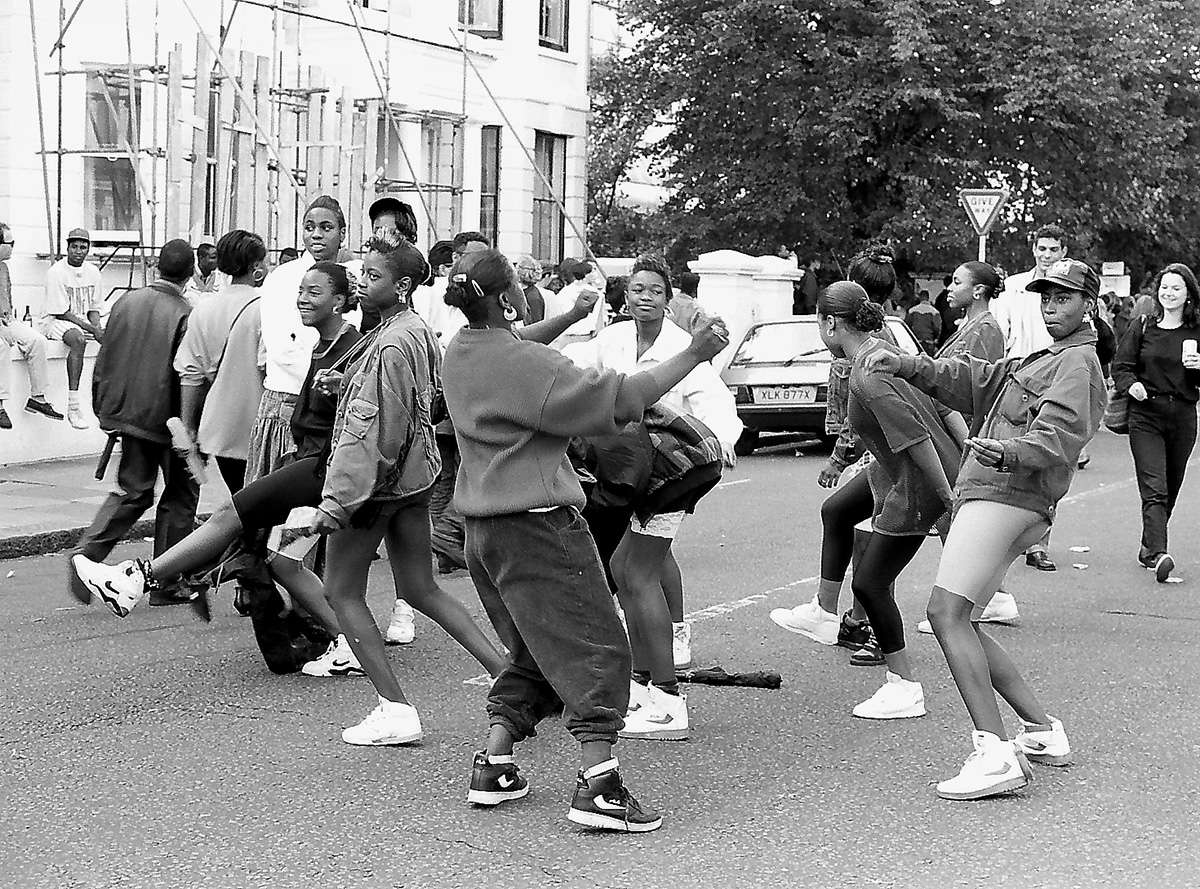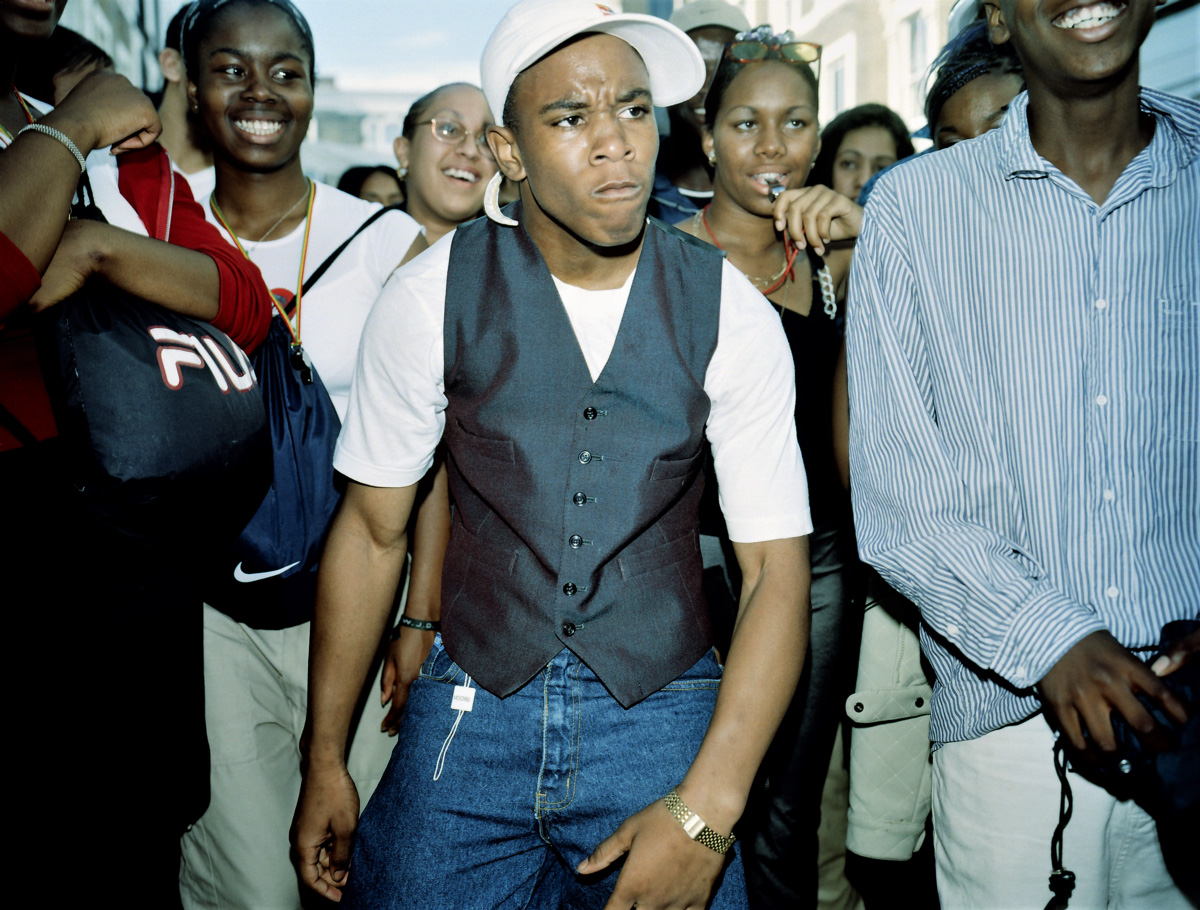Text by Drew Sawyer
The best photography is, like dance, a powerful impulse and a skilfully choreographed art. Just ask Liz Johnson Artur, who has been conscientiously photographing her encounters with individuals on the streets and at social gatherings for the past three decades. Her impossibly intimate pictures celebrate the nuances of everyday life in Africa, Europe, North America, and the Caribbean. It is no coincidence that many of her images feature people who appear to be rhythmically moving their bodies: dance has often provided Johnson Artur with new opportunities to connect with strangers, and in turn has given strangers the chance to perform for her camera.
Take, for example, a black-and-white photograph of two boys breakdancing amid a crowd in London, where Johnson Artur has been based since 1991. She recalls encountering the spectacle and struggling to get through the wall of onlookers. Eventually, someone shouted for others to let her into the circle, where she was able to record the entwined performers. In another image, Johnson Artur managed to photograph two men on the dance floor in a trance-like state, a mystical moment of transcendence that is heightened by their intense grasp, the smoke-filled room, and the rosary beads tenderly held in one man’s lips. Trust, intimacy, and movement: both pictures express the collaborative and social nature not only of dance, but also of photography as practised by the artist.

Johnson Artur’s desire to relate to others through photography began in 1986, when she visited New York for the first time, staying with a Russian family in a predominantly black neighbourhood in Brooklyn. The journey was a defining experience. ‘It was the first place I arrived with a camera. Everything overwhelmed me, the place and the people,’ says Johnson Artur, who was born to a Russian mother and a Ghanaian father in Bulgaria, and subsequently grew up in Germany with her mother. She became eager to meet – and see pictures of – other people and communities across the African diaspora.
After the trip, Johnson Artur returned to Germany and studied photography. Although she originally intended to return to New York, she instead moved to London and enrolled at the Royal College of Art. Soon after, she began working for magazines such as i-D, The Face, and Vibe, which allowed her to travel around the world and hone her skills. She calls the body of work that she has accumulated over the years her Black Balloon Archive. This title is derived from the song ‘Black Balloons’, which was originally written by Oscar Brown Jr for the Broadway musical Buck White. One line refers to the joy of seeing a large black balloon ‘dancing’ against a ‘snow-white’ sky; by the end, the singer croons, ‘We’ll fill the streets, with dancing feet, beneath the big ol’ black balloon’.
Johnson Artur has indeed filled her archive with dancing feet, but she is far from alone in her attraction to the subject. Since the rise of the small handheld camera in the 1920s, photographers around the world have been drawn to the dance floor. In the 1930s, Brassaï photographed friends, lovers, and dancers in Parisian bars with an intimate candour that’s still striking today. Malick Sidibé photographed at dance halls and soirées in Bamako, Mali during the 1960s. In the 1970s and 1980s, Nan Goldin and a group of fellow photographers, including David Armstrong, documented the most intimate experiences of friends and lovers dancing and embracing at clubs and apartments across Boston and downtown New York. The best work of all these photographers conveys their role as active participants rather than mere observers.

Among her peers, Johnson Artur’s practice and career trajectory overlap with those of Wolfgang Tillmans, who similarly moved from Germany to England in the early 1990s and became known for his photographs of raves, clubs, and queer nightlife that appeared regularly in i-D and other publications. Both artists establish a collaborative process with their models, and the resulting photographs reflect their own subjective experiences while also recording a specific dimension of global contemporary culture.
More recently, Johnson Artur has been photographing a close-knit community of artists, performers, dancers, and clubbers – such as Larry B (also known as Ms Carrie Stacks) and Miss Jason – who are associated with the monthly East London club night PDA. There is a sense of intimacy in Johnson Artur’s photographs of the group, born out of her respect for – and now growing friendship with – her subjects. These individuals keep company with others in Johnson Artur’s archive, which she organises in a more intuitive manner than most. The artist lives with them in her handcrafted notebooks and sketches, transforming images into materials made for touching, offering another way for her to physically connect with her subjects. In exhibitions, her pictures often fill walls, vitrines, and even the floors. Together, they create new dialogues and connections as viewers are asked to do the footwork.
For more of Liz Johnson Artur’s work, click here.
For more from #2 Dance, click here.



